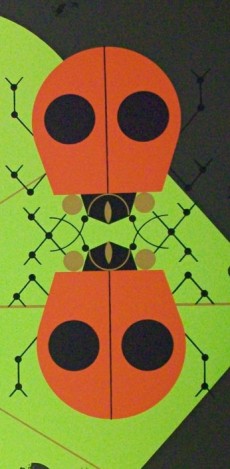There is an alliance between The Center for Cartoon Studies and The Montshire Museum of Science, which is almost as old as the former. I should know, for I was part of the first-ever class at CCS; and so, I was part of many first-evers, including the first-ever CCS field trip to the Montshire. We came equipped with sketchbooks and pencils and brushpens and charcoal; we departed with sketchbooks full of amazing rare things, the preserved moose and the preserved insects being among the most popular subjects to draw. Upon return to base, our task, or “drawing challenge” was to depict a story about a miniature figure among the specimens. I wove a semi-autobiographical narrative around the dead bugs. The result, “Insecticide” is one of my best works from my prolific two years at CCS:
Recently, I revisited my alma mater, and also returned to the halls of the Montshire. Of course, I carried a sketchbook. And a new brush. I'll share a few sketches:
Since my graduation, CCS has moved
onward and upward in so many respects—including collaboration with
the Montshire. The people of these two institutions have taken it to
the next level, with a new exhibit (on display at the Montshire
through February 3, 2013): Cartoonists' take on Charley Harper. It
provides a unique compliment to the traveling exhibit Beguiled by the Wild: the Art of Charley Harper. Harper was a famed nature artist,
best known for his seriagraph (silk-screen) prints of wildlife, in a
style he called "minimal realism." He made art for many
nature organizations, including the Cincinnati Zoo, Hawk Mountain
Sanctuary, and the National Park Service. On a trip with the Denison
outing club (pre-CCS), I saw a poster by Harper on sale, probably at
the visitor center of Bandelier National Monument. I knew that I had
to take it home, and adorn the ceiling of my cabin at The Homestead.
I didn't yet know Harper by name, but I recognized his remarkable
compositions of wild animals, distilled to their essence.
And so, in the Montshire, with a set of Harper prints at
one end of the room, the other is adorned by work by CCS students, taking inspiration from Harper and from nature. (Evidently,
I don't have a trademark on “Comics from the Wood.”) The colors
are vibrant; and while Harper was a master of telling a story with a
single image, the intrepid cartoonists apply minimal realism to a
stories composed of multiple images in sequence. The results are
charming, and well worth taking home, in the form of the comic book
collection of the CCS work, which can be found at the Museum shop.
And I can recall all this positive
detail about the exhibits, despite having lost my wallet on the trip
back. Subsequently, I have been pressed to replace all my essential
cards and Ids. Simultaneously, I have worked to prepare for
Christmas with family, in my old home in West Virginia. It is a way
of starting afresh, but with the weight of what has been and what's
to come. I have much to do, to re-evaluate my life and path, and the
pursue new challenges. I hope that I can take a hint from The Center
for Cartoon Studies, and rise to new frontiers.
Happy Holidays and Merry Christmas!
The two color images are by Charley Harper, the former for the National Park Service, public domain;
the latter is being used online to promote the traveling "Beguiled" exhibit.








